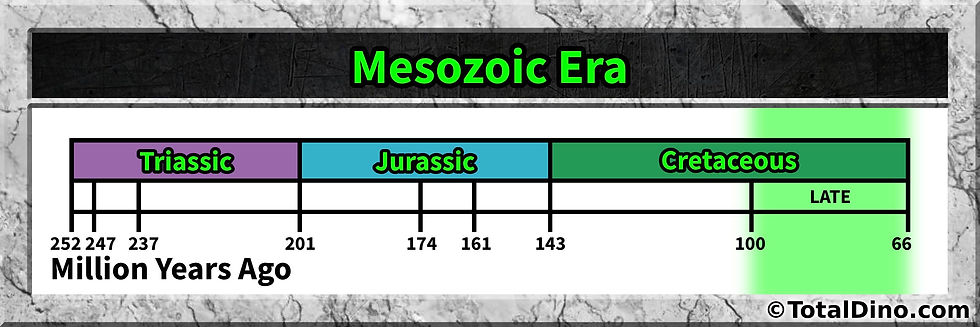Qunkasaura
- Total Dino
- Aug 25
- 3 min read
MEANING: Qunca lizard
PERIOD: Late Cretaceous
CONTINENT: Europe
Qunkasaura is a saltasaurid titanosaur, and its discovery marks the first instance of two distinct lineages of this group present in the same locality. In the Late Cretaceous, Europe was a large archipelago, and the coexistence of these differing lineages indicates that saltasaurids arrived in the Iberian Peninsula much later than other groups of dinosaurs.

Abstract from paper: A new lithostrotian titanosaur, Qunkasaura pintiquiniestra gen. et sp. nov., is described based on a single partial skeleton from the late Campanian-early Maastrichtian fossil-site of Lo Hueco (Cuenca, Spain). This new taxon is supported by an exclusive combination of characters that highlights strong convergences with members of the South American Aeolosaurini. Qunkasaura allows to reorganise the complex phylogenetic relationships of the increasingly diverse finicretaceous sauropods of Europe. Phylogenetic analyses places Qunkasaura within Saltasauridae and possibly Opisthocoelicaudiinae, together with Abditosaurus. A new clade is established, Lohuecosauria, including Saltasaurus, Lohuecotitan, their most recent common ancestor and all its descendants. Two distinct Ibero-Armorican Campanian-Maastrichtian saltasauroid lineages are recognised: (i) Lirainosaurinae that is exclusive from Europe, and (ii) a saltasaurid lineage with possible opisthocoelicaudiine affinities, with a Laurasian distribution. Lirainosaurinae was a relict lineage including possible dwarf forms that evolved in isolation after reaching Europe before the Late Cretaceous through the Apulian route. The occurrence of opisthocoelicaudiines in Europe may be the result of a Late Cretaceous interchange between Europe and Asia. No evidence of insular dwarfism is found in the Ibero-Armorican opisthocoelicaudiines suggesting that they may have been newcomers to the area that arrived before the ‘Maastrichtian Dinosaur Turnover’ in southwestern Europe.
Qunkasaura is from the Late Cretaceous. The Cretaceous is the third and final geological period of the Mesozoic Era, with the Late Cretaceous making up roughly the second half of it, lasting from about 100 to 66 million years ago. It was a time of significant evolutionary change, with dinosaurs reaching their greatest diversity before the mass extinction at the end of the Cretaceous.
The Cretaceous was a period with a relatively warm climate, though the Late Cretaceous experienced a global cooling trend, caused by falling levels of carbon dioxide in the atmosphere. The continents were nearing their present positions, but high sea levels flooded low-lying regions, turning Europe into an archipelago, and forming the Western Interior Seaway in North America. These seas were home to a variety of marine reptiles, including mosasaurs and plesiosaurs, while pterosaurs and birds shared the skies.
On land, dinosaurs continued to thrive and diversify during the Late Cretaceous, producing many of the most well-known goups, including tyrannosaurs, hadrosaurs, and pachycephalosaurs. Established Cretaceous dinosaur clades like the ceratopsians, ankylosaurs, and dromaeosaurs continued to flourish. Sauropod species consisted almost exclusively of titanosaurs, which seemed to be confined to the Southern Hemisphere for much of the Late Cretaceous. Flowering plants and grasses diversified and spread, becoming the dominant flora similar to what we see today.
The Cretaceous (along with the Mesozoic) ended with the Cretaceous-Paleogene (K-Pg) extinction event, a large mass extinction in which many groups, including non-avian dinosaurs, pterosaurs, and large marine reptiles, died out. This event, likely triggered by an asteroid impact, is marked by the abrupt K-Pg boundary, a distinct geologic layer separating the Mesozoic and Cenozoic Eras. In its aftermath, mammals and avian dinosaurs rapidly diversified, becoming the dominant land animals of the Cenozoic Era.

Qunkasaura is a saltasauroid titanosaur. Saltasauroids are a clade of derived titanosaurs that thrived during the Late Cretaceous and are among the last and most specialized members of the sauropod lineage. They are primarily known from South America, though fossils have also been found in Asia and elsewhere. These sauropods tended to be smaller and more compact than their earlier relatives, with some species estimated to have been under 15 meters in length - small by sauropod standards. Despite their reduced size, they retained the characteristic long necks and tails of their lineage.
One of the most distinctive traits of saltasauroids is the presence of bony armor, or osteoderms, embedded in their skin - a rare feature among sauropods. This dermal armor suggests a possible evolutionary response to increased predation pressures during the Late Cretaceous. Their skeletons often show adaptations toward a more robust and stocky build, possibly indicating changes in locomotion or lifestyle compared to earlier titanosaurs. As one of the last surviving sauropod groups before the end-Cretaceous extinction, saltasauroids represent the final phase in the long evolutionary history of these giant herbivores.











